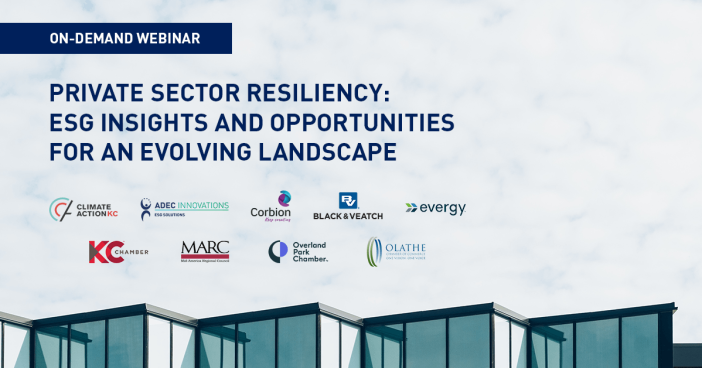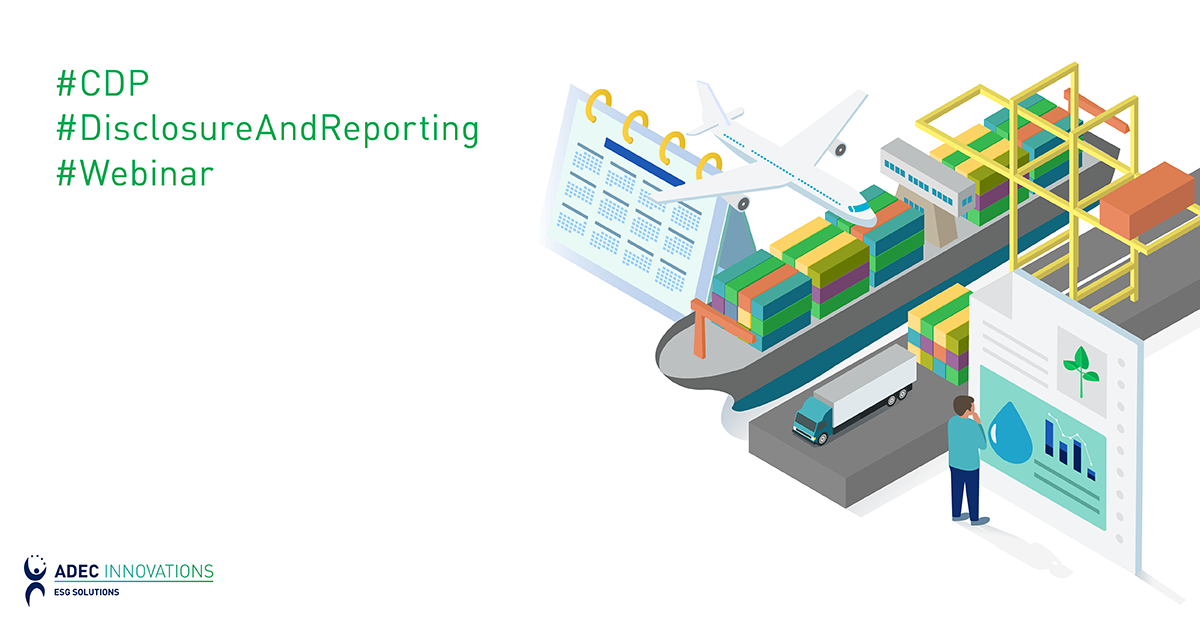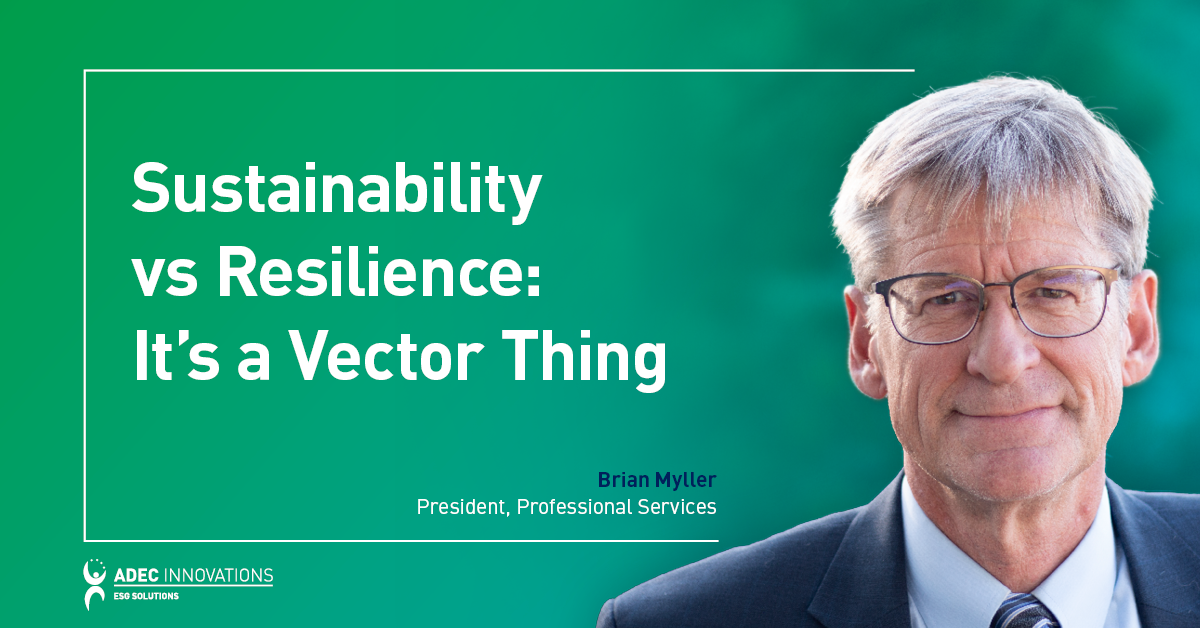In our latest interactive webinar with Climate Action KC (CAKC), Private Sector Resiliency: ESG Insights and Opportunities for an Evolving Landscape, we brought together Kansas City business leaders to share their experiences, successes, and challenges addressing ESG from different industries in an ever-changing landscape.
In a complex and evolving environment where social awareness in the public eye has heightened, a company’s reputation and how they are operating has become increasingly relevant. City Mayor Eric Mikkelson of Prairie Village, Kansas lead the discussion, emphasizing that private sector resiliency through ESG during times of significant disruption is one of the hot topics for businesses around the world.
Companies from all industries are recognizing ESG as a vital part of the way they do business. The market has shown that a company’s approach to ESG—from strategy and planning, to action and collaboration, to monitoring and reporting—will play a key role in its success and longevity. To learn more about ESG and resiliency in the private sector, including how other business leaders are approaching ESG, check out a recording of the webinar here.
ESG Through an ESG Lens
As Associate Director for ESG Technical Services at ADEC ESG Solutions, I began the discussion by providing an overview of ESG within the unique context of the current climate. The only constant in life is change, especially in business. In order to understand how ESG can build resiliency and longevity within your company, it is imperative to understand these changes and shifts in the current landscape, and how they are directly affecting your business and ESG, respectively.
The global crisis also demonstrates that companies have the ability to significantly influence, enable, and collaborate with their employees, supply chains, and local communities.
The largest shift in perspective we are seeing in the market during COVID-19 is with investors on their concern and interest in companies’ climate-related risks and the reporting of those risks. Factors such as the current pandemic and climate change have dramatically impacted and reshaped how investors are assessing current and prospective clients. It has pushed a need for increased transparency so that businesses are held more accountable, are aware of how their operations are affecting the environment, and are taking measurable action to decrease that impact. The global crisis also demonstrates that companies have the ability to significantly influence, enable, and collaborate with their employees, supply chains, and local communities.
The most impactful way to address transparency is with targets and actions. I presented a roadmap that identifies the parallels of what CAKC is doing to move towards their regional action climate action plan alongside what other companies are doing, presenting opportunities in aligning similar goals. While all industries are connected through their goods, services, and products, local government is the hub that connects all these different companies together.
How is ESG Affecting Operations and Businesses?
Black & Veatch, Corbion, and Evergy addressed the first main topic on how ESG has impacted their operations and transformed the way they do business, in an engaging discussion. While each represents different industries, their discussion strikingly revealed an underlying similarity in that they are all working to address the same types of issues and solutions for their customers as a result of market pressure related to ESG.
In tackling these complex challenges, significant opportunities are found through innovation and re-framing problems as opportunities.
As businesses see ESG pushed to the forefront of their daily operations, Elizabeth Musoke-Flores, Sustainability Specialist at Corbion, spoke on the customer and investor dynamic, as there is a clear focus on integrating ESG principles and strategies to ensure that they are demonstrating transparency to their investors through reporting to such platforms as CDP. Similarly, Ben Postlethwait, Manager, Biology Conservation and Sustainability Programs at Evergy stated that they use CDP as global benchmarks to keep track of their ESG performance. James C. Schlaman, Director of Planning, Water, at Black & Veatch noted that as a result of ESG pressure, different innovations have evolved across the industries they serve, where sustainability is a core pillar of their strategies and overall frameworks internally. Each business leader discussed in depth how they are successfully integrating ESG initiatives and programs in light of this unique landscape.
What are Your Challenges Managing ESG? Opportunities?
Each business leader detailed the unique challenges presented in looking to provide opportunities and solutions to help serve their customers’ needs, particularly in their ESG goals. Whether they are related to vulnerability to climate and weather issues, keeping up with technology advancement, geography, creating sustainable systems and processes, or quantifying social impacts and data management, fully understanding the issues is critical in assessing, identifying, and mitigating each challenge. Yet it is often difficult to grasp the different complexities ESG poses.
In tackling these complex challenges, significant opportunities are found through innovation and reframing problems as opportunities. Evergy commented that in “looking beyond the transactional aspect of an energy bill and seeing opportunities that they can help uncover for their customers,” it has presented key opportunities for them to further engage and strengthen the relationship with their customers. Corbion discussed how investing in ESG helps build resiliency and shows leadership, ultimately differentiating them from their competitors and improving overall employee engagement and retention. The challenges Black & Veatch encountered through ESG became opportunities as they experienced the “…benefit of investing in resilient infrastructure to mitigate against those vulnerabilities and being able to connect the dots to investors,” resulting in greater stakeholder support.
Collaboration with Local and Federal Government
The final question brought the webinar full circle to CAKC, as each business discussed their collaboration with local and federal government with respect to ESG for their respective communities. This topic sets the stage for the last session of this three-part webinar series, set for November. We will further assess the different collaborations in place, and will talk with local and government members about implementing ESG solutions and opportunities in collaboration with private industry.
Our panelists were in consensus that businesses cannot address and effectively tackle ESG issues effectively without partnership and collaboration. To find out why, watch the full webinar here. Collaboration is critical in private sector longevity, prosperity, and resiliency. As public and private entities start to align their goals for ESG, there are significant opportunities for partnerships. And, collaboration helps streamline solutions to meet respective ESG goals and objectives from a customer and investor’s perspective. It is crucial for businesses to identify synergies across companies and different sectors that they work with so that together, they can make an effective and meaningful impact on ESG.
Would you like to learn more? Watch the full webinar here for a detailed picture on ESG for private sector resiliency and how businesses are finding opportunities in their approach to ESG.
You can also get the latest updates on the last session of our three-part webinar series in November by subscribing to our monthly newsletter, Greenwatch.




